The National Museum of Malaysia was opened on 31st August 1963. Visit the National Museum of Malaysia is like reading a brief history of the country, live! It is the repository of Malaysia, showcasing its rich culture and historical heritage.
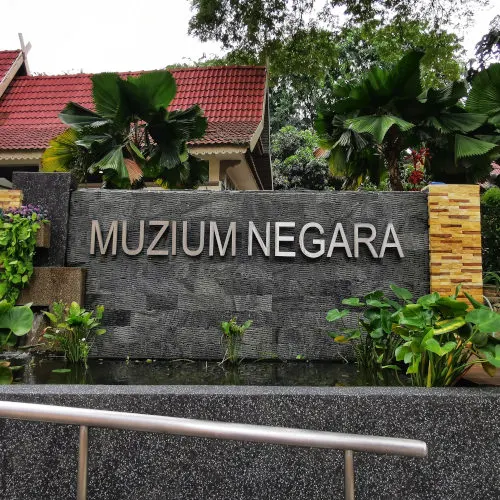
The National Museum of Malaysia is close proximity to the central business district of Malaysia. You can easily take a taxi or hire a car to visit the museum. There are ample parking lots, which are only charged RM3 per entry.
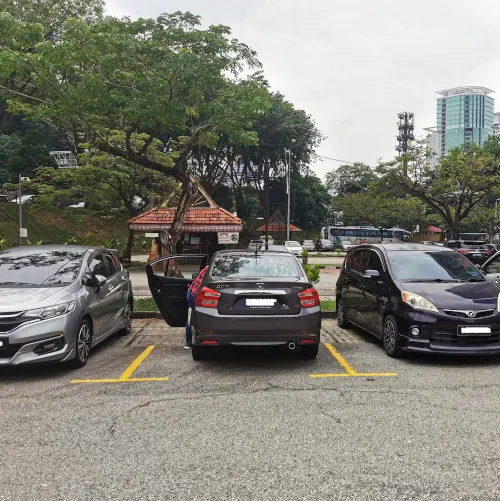
The entrance fee is only RM2 for Malaysian and RM5 for visitors from other countries, which I think is more than reasonable.
I will show you what I have seen during my visit in this article. I will start from the museum's outdoor area, followed by the four main galleries.
Join me in visiting the National Muzeum of Malaysia on this virtual tour.
1. The outdoor area + entrance
The outdoor area has a few free attractions. You can pass through the National Museum of Malaysia to the Perdana Lake Gardens by taking the overhead bridge crossing the highway.
There are also some vintage car displays on the right.
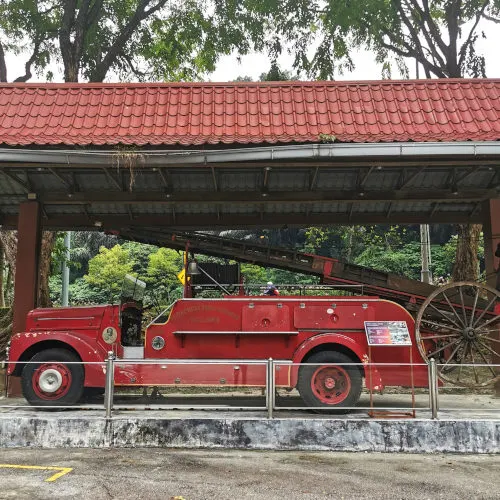
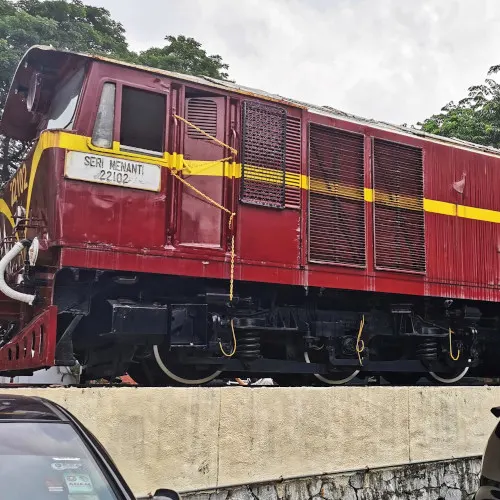
Don't miss out the video shot during our visit to the National Muzeum of Malaysia. It is at the end of this article. 👇👇
a. Gate of Kuala Kedah Fort
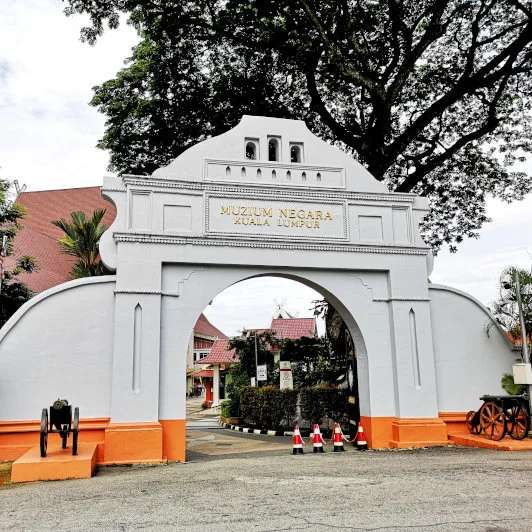
The gate is also the main entrance to the museum.
It is the replica of Kuala Kedah Fort located at the mouth of the Kedah River. Kuala Kedah Fort is the only Malay fort made of bricks still standing and can be seen today.
This gate symbolizes the strength of the Malay Sultanate in Malaysia through the years.
b. Istana Satu
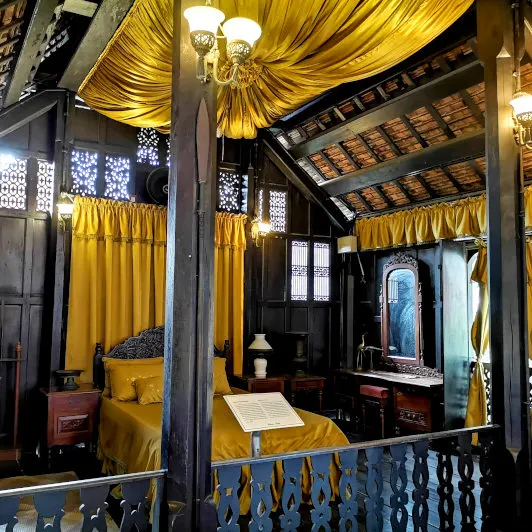
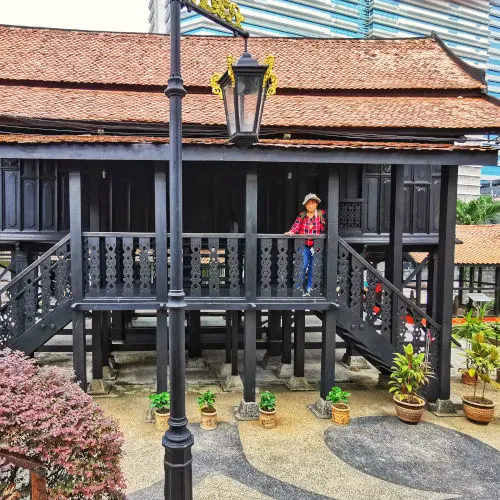
Istana Satu is part of a palace complex that was built at the foot of Bukit Puteri, Kuala Terengganu, during the reign of Sultan Terengganu the XI, Sultan Zainal Abidin III (1881-1918).
The palace was built without iron nails and assembled with wooden pegs. The original structure consisted of two units of the main house. This palace is one of those two units in which a private individual purchased the other unit.
Istana Satu was reconstructed in the National Museum of Malaysia in April 1974.
c. Kelirieng (Burial Poles)
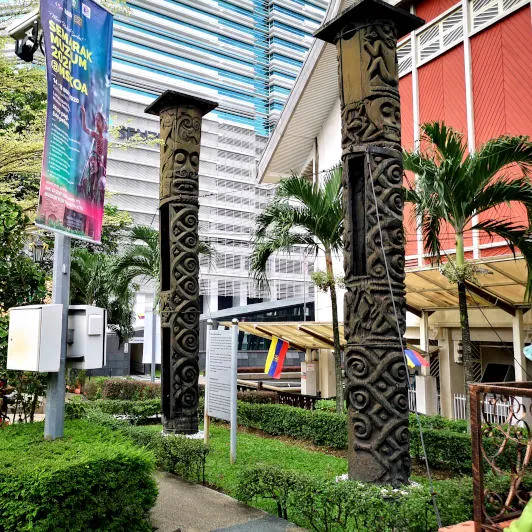
In the past, it was customary to rebury their dead by collecting the bones from the coffin and placing them in a jar far from their houses. The jar would then be placed inside or around the pole, as shown here.
These burial poles, estimated to be around 200 years old, were donated to Muzium Negara by the Sekapans (a sub-group of the Kajang people) and the Punan Bah Community from around Belaga in the upper Rajang River region of Sarawak.
d. Batu Aceh (ACEHNESE STONES)
Bato Aceh is a type of gravestone: These gravestones, carved by the Acehnese between the 15th and 19th centuries, were widely distributed in the Malay Indonesian archipelago and were used to embellish the graves of Malay royal families and chieftains. Therefore, these tombstones deserve to be considered a prominent Malay heritage.
They have been preserved here as a symbol of Malay creativity, inventiveness, artistry, and a past way of life.
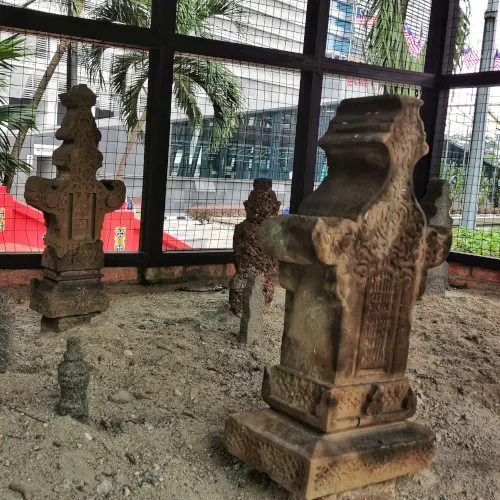
After getting the ticket, we are at the central hall which acts as the place for temporary exhibitions and cultural events.
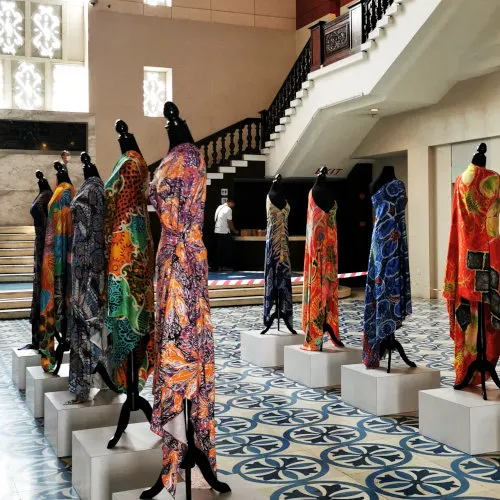
From the central point, you can access the four exhibition galleries, two on the ground floor and another two on the first floor.
2. Gallery A - Early History (prehistoric times)
This gallery brings visitors to explore the formation of the earth's surface and relish the way of life of the early society through each artifact on display. Visitors also have the opportunity to get to know will also understand the evolution from the Paleolithic period to the bronze age.
Gallery A displays the artifacts from the Last Glacial that occurred 20000 years ago to the present time. I felt like going back to school and attending a history class.
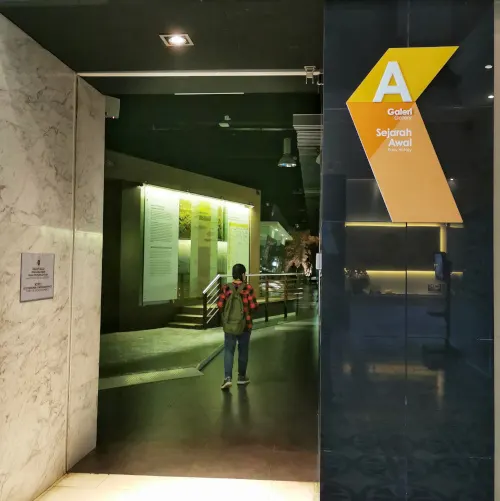
a. Sunda and Sahul Platform
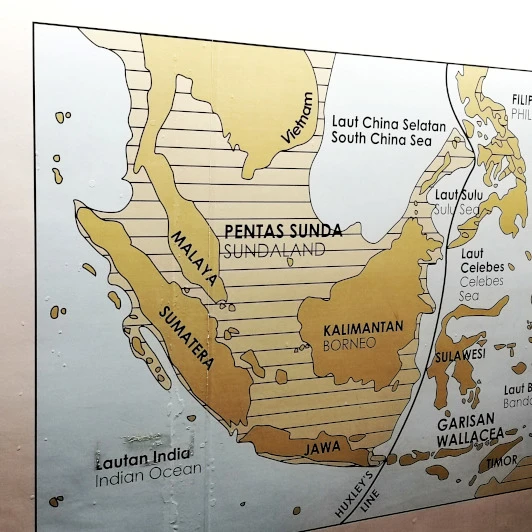
The sea level of Southeast Asia was 120 meters below the present level, exposing the South China Sea, Java Sea, and the Straits of Melaka as a landmass known as the Sunda Platform.
Humans and animals could wander freely between the mainland and insular Southeast Asia during this period, bringing their cultural heritage and the technique of making stone tools.
The climate of Southeast Asia became warmer around 18,000 years ago. As a result, the sea level began to rise, drawing the Sunda Platform and reaching the present-day sea level 10,000 years ago during the Holocene.
b. The Paleolithic Period (the Old Stone Age)
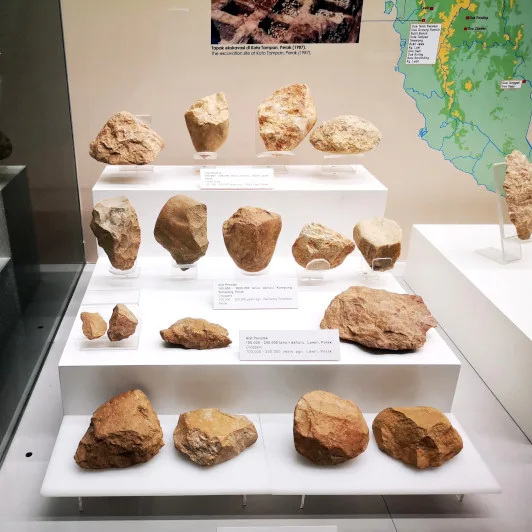
In Malaysia, the earliest evidence of human activity dates back to about 300,000 years ago. The Malaysian Palaeolithic is characterized by the chopping and flake tools traditions, especially from quartz and gravel from the river.
The Paleolithic tools at Kota Tampon were embedded in the Toba volcanic ash dated 75,000 years ago. The Palaeolithic communities are said to practice nomadic life, hunt games, catch fish, and also collect and gather plants as food.
Bark Cloth Beaters.
The stone tools with the inscribed criss-cross line beat and soften tree bark to make a cloth.
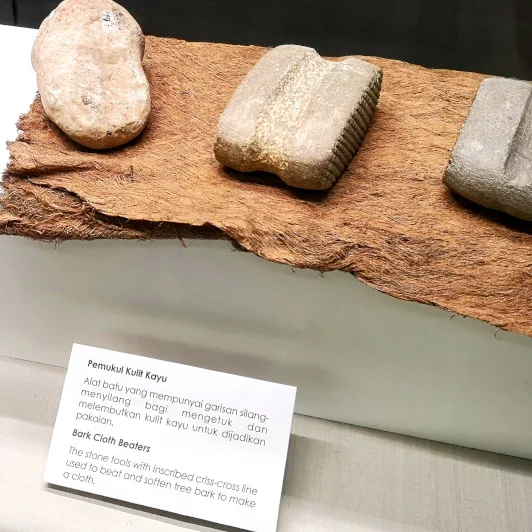
c. Neolithic Age (the New Stone Age)
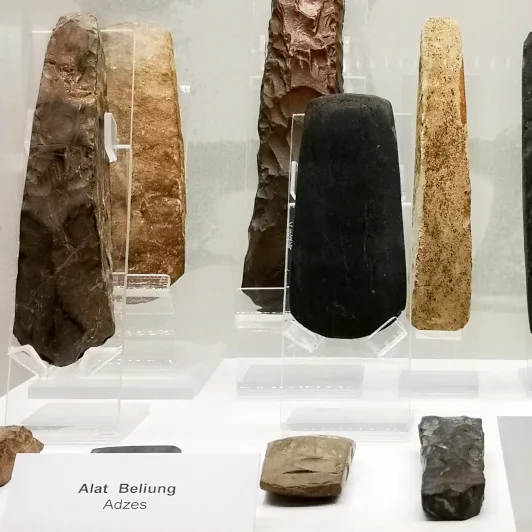
Approximately 4000 years ago, communities of this region started to produce stone tools, pottery, and the use of fire in their life.
This age is characterized by the existence of stone tools such as the adze and axes.
Neolithic communities also practiced rudimentary farming such as planting crops, domesticated and reared animals, and may also have been involved in barter trading.
They put on attires made from the bark of trees.
Stone slab burials
The stone slab or cist graves are created with stone slabs placed on top of the other to form a grave with the head end wider than the foot. This archaeological evidence indicates this practice's existence since the Métal Age about 300 BCE and continuing through the Proto-History Period and ending around 1400 AD.
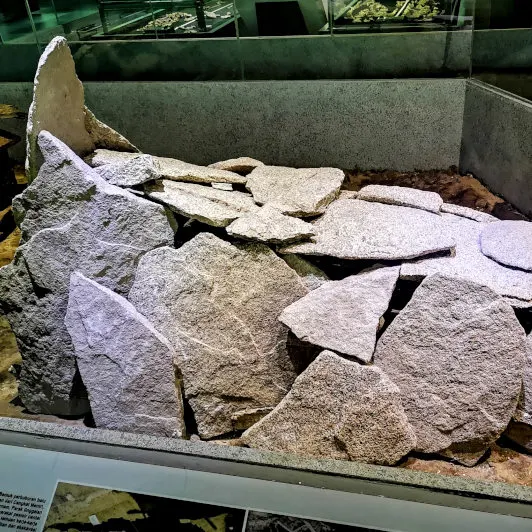
JAR / URN BURIAL
Jar or urn burial is practiced among communities in Sabah, Sarawak, and Terengganu and dates back to the late 2nd century BC. Human remains were interred in jars at this site.
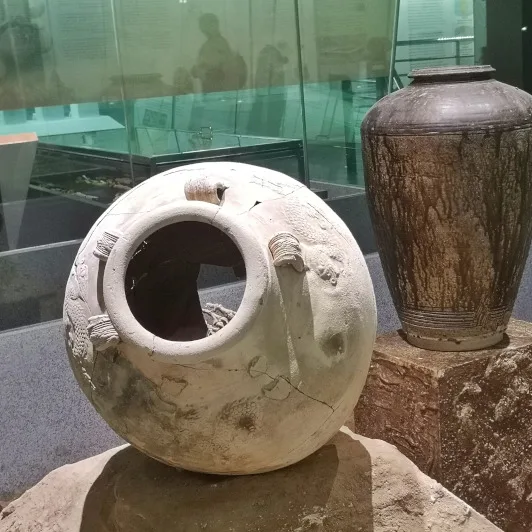
THE BUJANG VALLEY, KEDAH
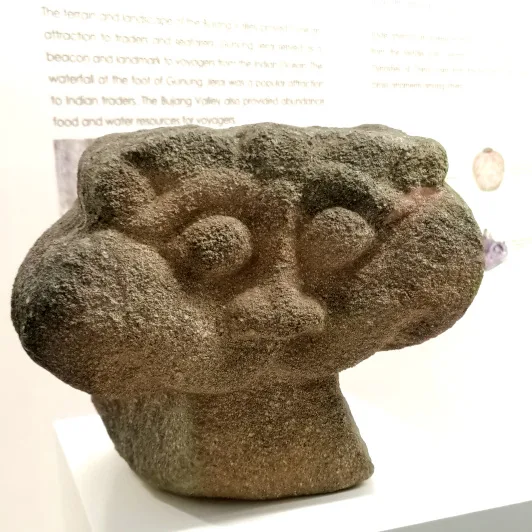
Bujang Valley was established in the 4th century A.D. It is considered the earliest kingdom in Malaysia and was also famous as an international trading center between the 4th and 14th centuries A.D.
Megaliths
The megalithic traditions in Malaysia encompass the use of large granite blocks shaped as menhirs, dolmens, and slab graves.
While the culture of megaliths like Stonehenge in England is regarded as a universal practice, Its form In the Peninsula, Malaysia, is quite unclear. Although local communities regard these as burial sites, archaeological research carried out at several related sites does not support this view. Some even believe these as sacred sites and hold religious rituals to invoke the favor of the resident spirits, especially at the beginning of the rice planting season.
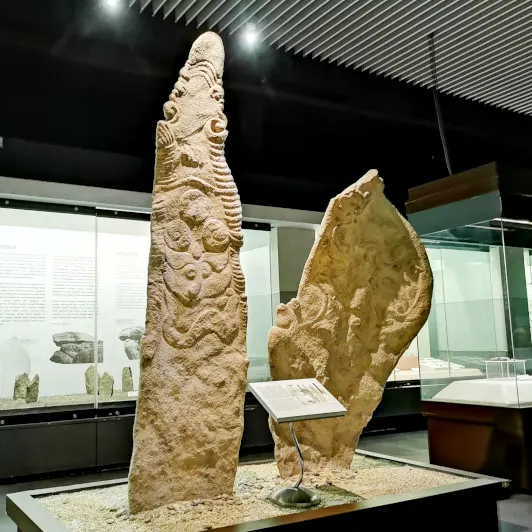
d. Iron Age (early A.D. until the 7th century A.D)
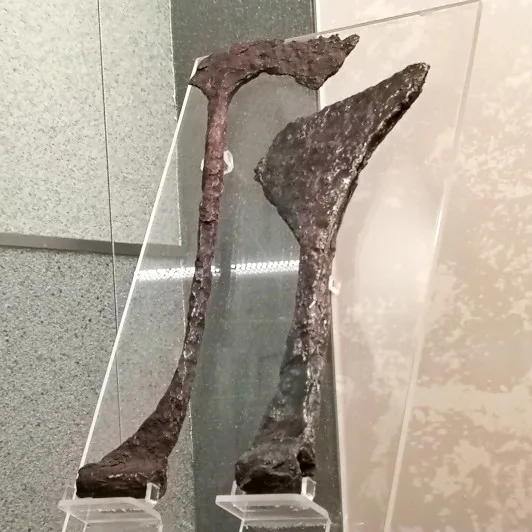
Iron Age is characterized by discovering iron artifacts comprising axe, adze, sickle, knife, and spearhead. These iron implements are believed to have handles made from wood or rattan.
Some of the artifacts found have unique shapes resembling the rib bones of animals. These artifacts are called ‘tulang mawas’ (ape bones).
e. Bronze Age
Bronze bell from Kampung Pancu, Muar, Johor was gazetted as the National Tangible Heritage Object In 2009.
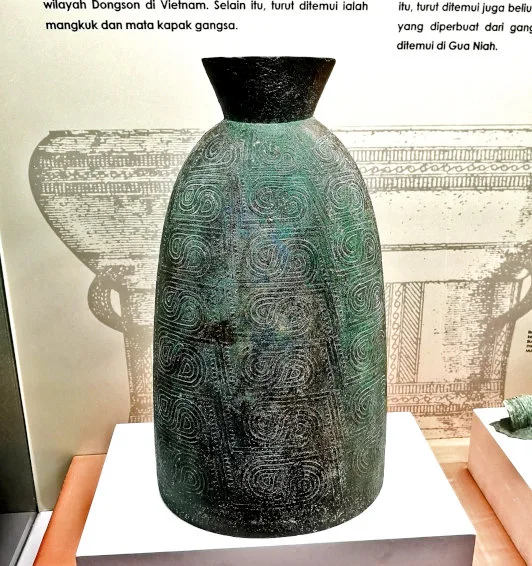
f. Others
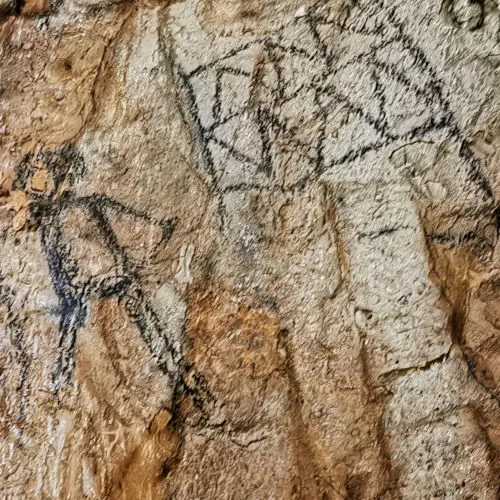
2. Gallery B: Malay Governments
Gallery B is about the evolution of Malay civilization, particularly the overview of Malaysian history. It highlights the Malay Kingdoms, the glorious era of the history of Malay-Islamic civilization in this part of the world.
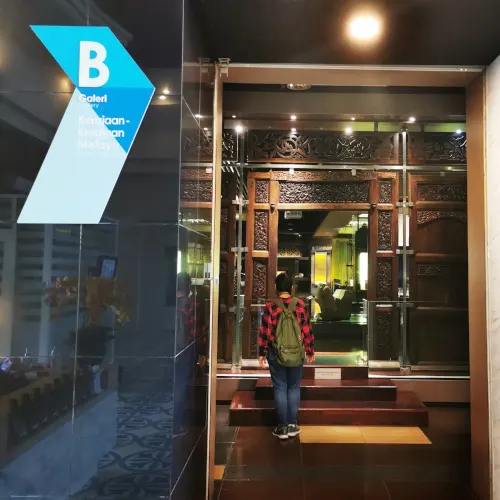
Gallery B displays items collected from the era during the Malay governments, before the colonial era
a. The wall and door of the Palace of Setul
This wall and the door in it belonged to the Palace of Setul. The wall is made of teak, carved with leaves and flowers, and symbols of the Malay State of Setul with mixed Javanese and Malay motifs.
The Malay Sultanate of Kedah governed the Malay State of Setul from 1843 until 1909 when it was ceded to the Kingdom of Thailand following the Treaty of Bangkok. The door is more than 120 years old.
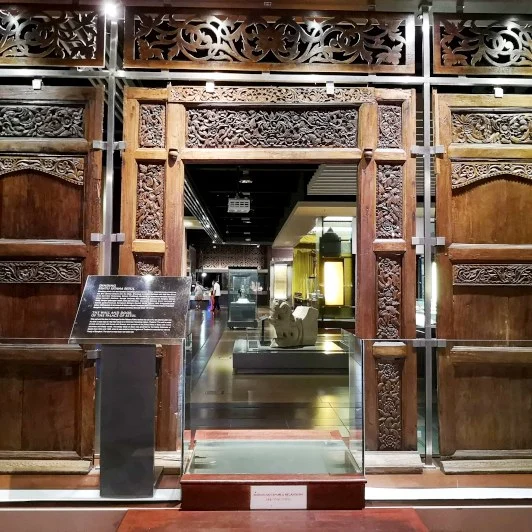
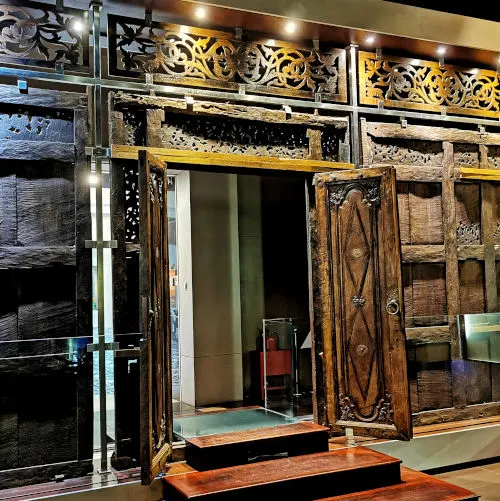
b. Figurehead of the royal boat
This figurehead that shapes like a dragon are made of wood from a jackfruit tree. It was owned by the royal family of Pahang in the late 19th century and more than a century ago.
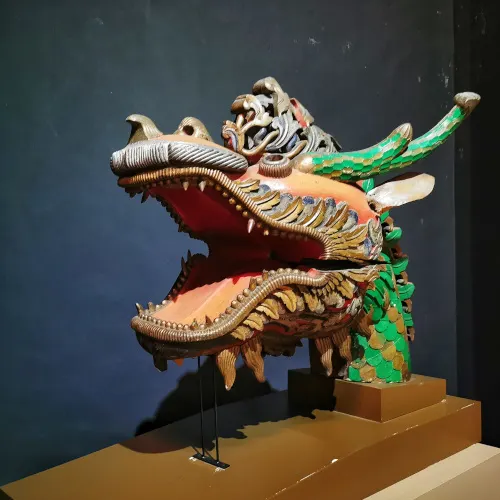
c. The Ibnu Sardan stone
The stone is discovered in the Bujang Valley, Kedah. It is among the evidence of the presence of Islamic Civilization om the Bujang Valley.
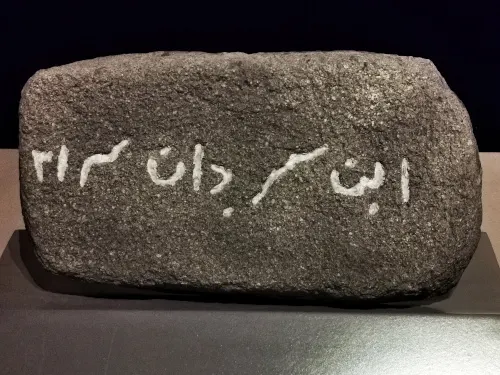
d. Artifacts recover from the shipwreck
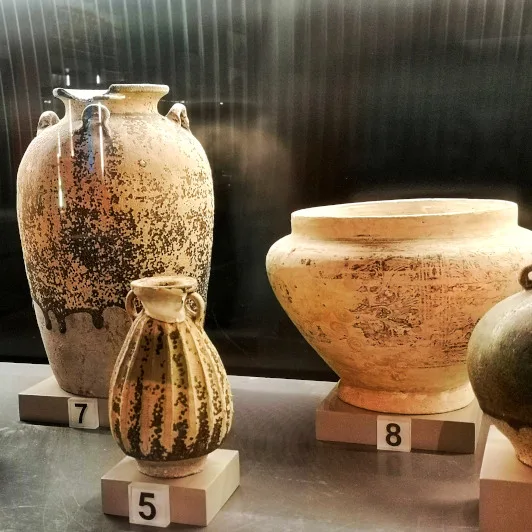
No 7 - A small Sisatchanalai black glazed jar
N0 8 - Sukhotai black glazed decorated jar
Most of the ships discovered were Chinese, from the Song Dynasty (AD 960-1279), the Ming Dynasty (1368-1644), and then the Qing Dynasty (1644-1912).
e. A vest with versus
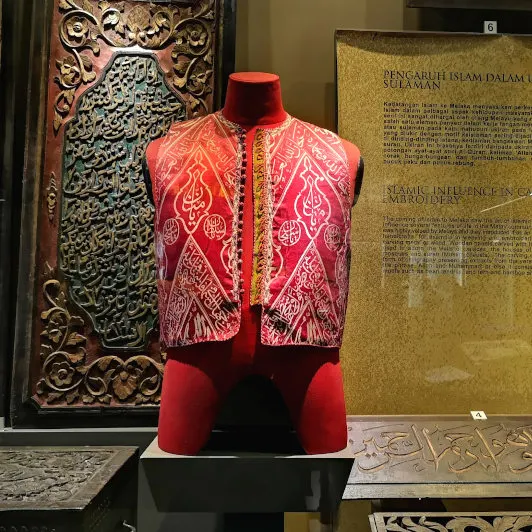
This garment was worn as an undershirt intended to safeguard the wearer in battle. Made of red silk, it is inscribed on the front with verses from the Holy Quran. Its estimated age is 100’years.
f. COSTUME AND PERSONAL ORNAMENTS
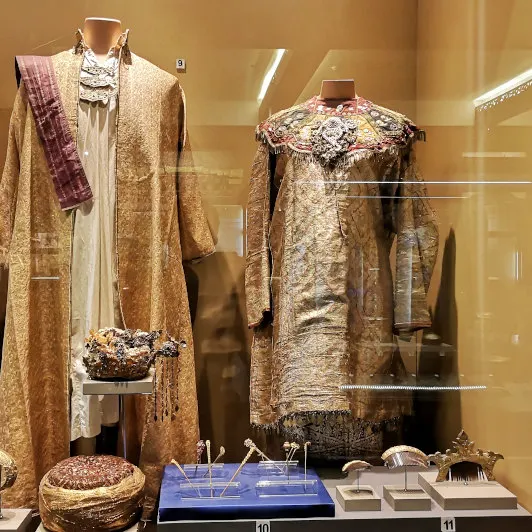
The coming of the foreign powers to Melaka has indirectly influenced the local community. For example, the designs of the clothing of the Malay people have begun to incorporate elements of the traders’ clothes, especially from the Indian Muslims and Arabs.
g. The royal throne
The royal throne was once the symbol of power used by Malay monarchs. Its high aesthetic value signified the high rank of a Ruler.

h. Islam comes to Melaka
The conversion of Sultan Megat Iskandar Shah was an important event in the history of Malaysia.
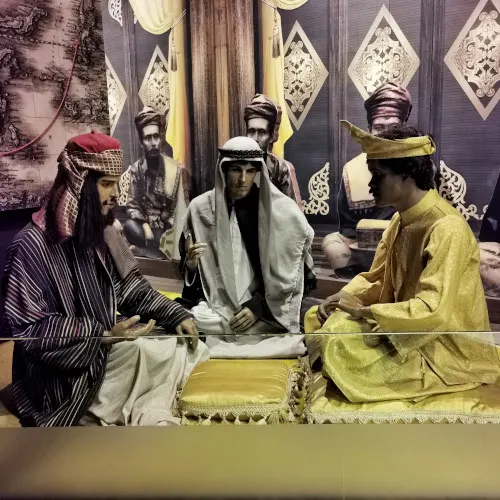
3. Gallery C: Colonial Era
Gallery C is about the local history during the colonial era in Malaya, Sabah, and Sarawak. It tells the story of how the Portuguese, Dutch, British, and Japanese colonized and invade this region.
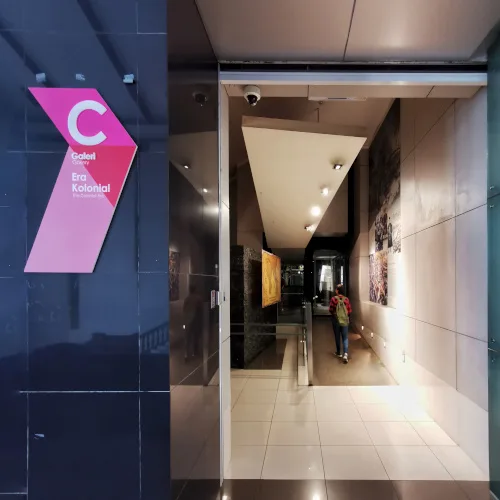
a. The Portuguese in Malaka
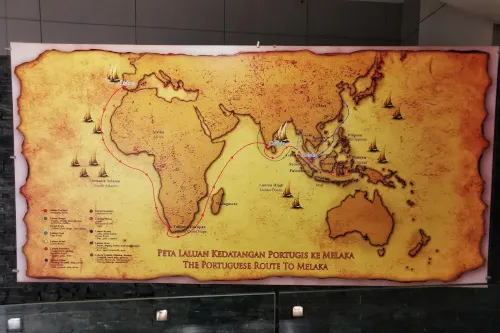
The Portuguese attacked Malacca in 1511, under the leadership of Alfonso de Albuquerque. Sultan Ahmad put up a resistance but it was defeated. The descendants of the Malacca Sultanate founded a new sultanate in Johor, known as the Johor /sultanate.
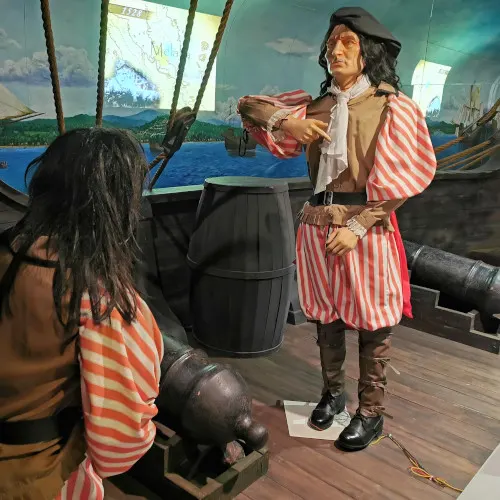
b. The battle of Tanjung Tuan (the invasion of the Dutch)
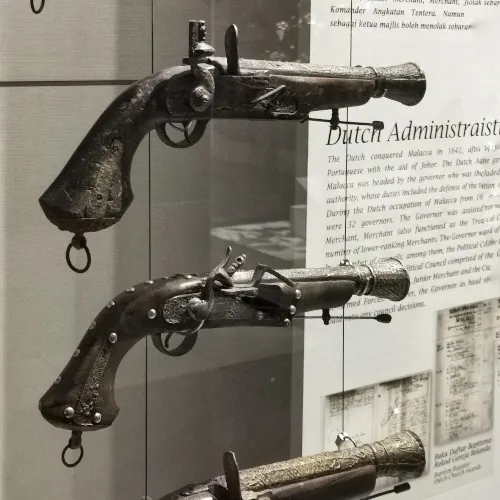
With the collaboration with Johor and Aceh, the Dutch ended the Portuguese control of the Straits in 1641.
c. The British occupation
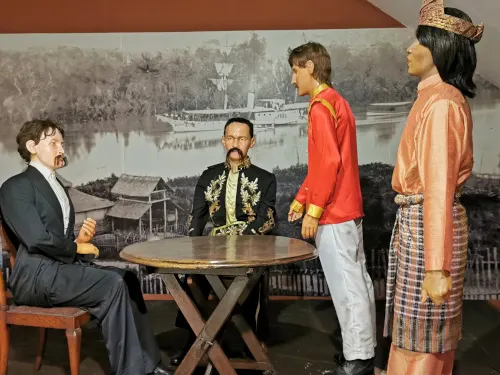
The British occupied Penang (1784), Singapore (1819), and Malacca (1795).
In 1874, the Pangkor Treaty was signed. One of the terms of the treaty was that Raja Abdullah would be acknowledged as the legitimate Sultan of Perak, but advice had to be sought and adhere to all matters except those pertaining to the religion and customs of the Malays.
d. Occupation by the Japanese (1941-1945)
The Japanese attacked Malaya in 1941, during World War Two.
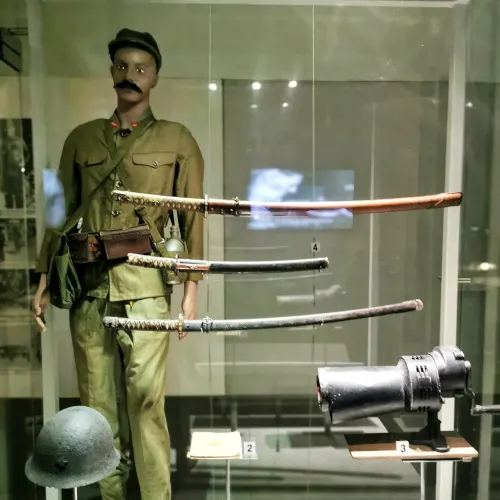
d. Tin dredges
Tin mining was one of the major economic activities in the colonial era. One of Malaysia's largest tin dredges, first built in 1938, rebuilt in 1963, and especially equipped for working tailings. The dredge is powered by electricity and has a total of 2004 horsepower; the pontoon is 75 meters long and 19.5 meters wide. It has 117 manganese buckets, each with a capacity of 0.51 cubic meters and capable of digging to a depth of 31.5 meters.
4. Gallery D: New Malaysia
Gallery D is Malaysia today's gallery which displays Education, Nationalist Movements, the Malayan Emergency, Independence, the Formation of Malaysia, Malaysian Culture, and the Achievements of Malaysia.
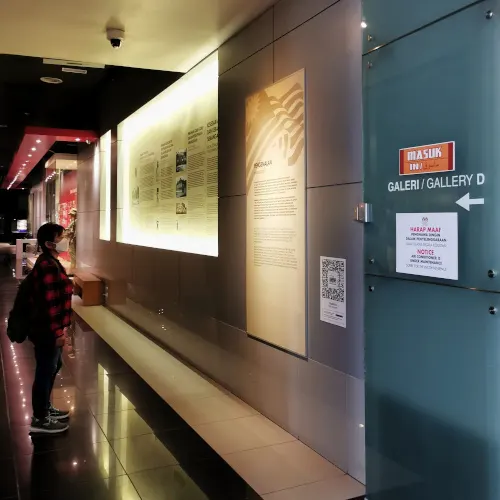
After the Japanese surrender in 1945 at the end of the Second World War, the British then introduce the Malayan Union plan.
It changes the status of Malay from a British protectorate to a British Crown Colony. The Malay opposed the creation of the Malayan Union. The anti-Malayan Union movement forced the British to consider forming an administration that would eventually lead Malays to be a self-governing, independent state.
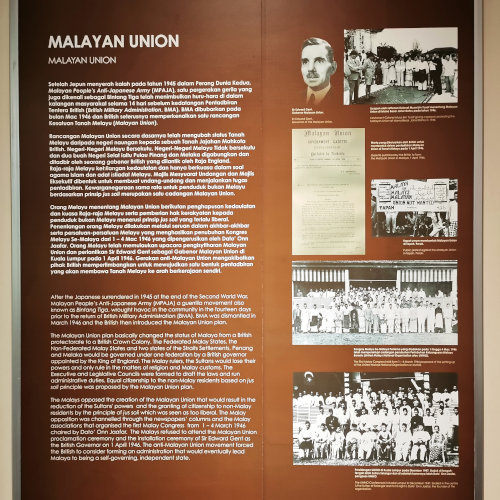
Malay opposition to the Malayan Union was a huge success. As a result, the Federation of Malays was formed in 1948. It marked the return of the sovereignty of the Malay states. This has become the basic framework of the establishment of the Federation of Malays in 1957.

The flag was raised for the first time on 31 August 1857, marking the birth of the independence of a nation called the Federation of Malaya, and the end of the colonization of the country.
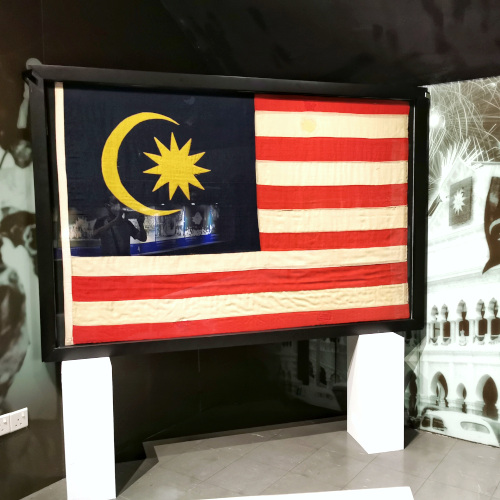
The historic moment was witnessed by thousands of people led by the first Prime Minister, Tunku Abdul Rahman.
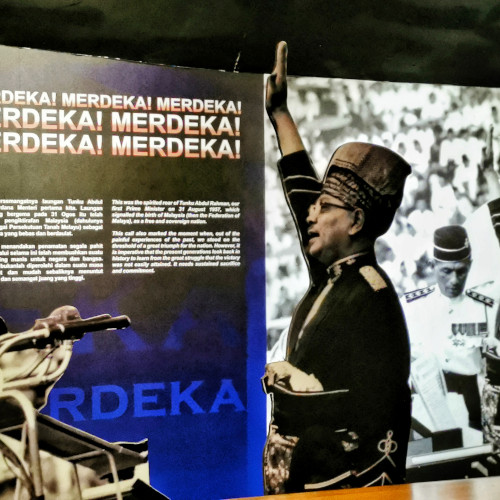
Watch our video shot at the National Museum of Malaysia. 👇👇
If you have come so far reading this blog post, don't miss out on the video we shot during our visit to the Selangor-Japan Friendship Garden. Click the image below to watch on YouTube (shot in high definition!).
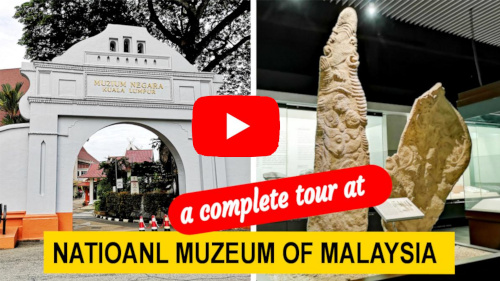
Brief information about the National Museum of Malaysia
- Opening hours: 9.00 am to 6.00 pm
- Admission fee :
- Local visitors: RM2 for Malaysian above 12 years old, free for children in uniforms.
- Foreign visitors: RM5 for adults above 13 years old, RM2 for children 6-12 years old, free for children below 6 years old.
- Address: Jabatan Muzium Malaysia, Jln Damansara, Perdana Botanical Gardens, 50566 Kuala Lumpur, Federal Territory of Kuala Lumpur
- GPS: 3.137955215190485, 101.68744219860318
- Official website: Click here
Other best places to visit in Malaysia
- Best gardens at Cameron Highlands. If you like beautiful gardens, you will be delighted by the beautiful images shot during our trip to four famous gardens and plantations at Cameron Highlands.
- What are you planning for your next holiday? Check out our article: Langkawi – 15 Things to do for a perfect 4D3N tour.
